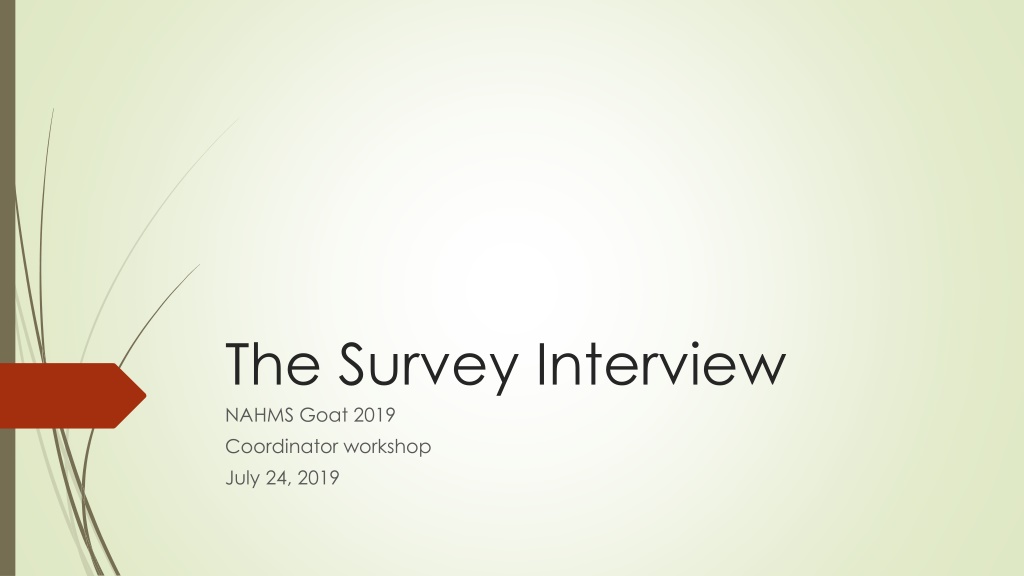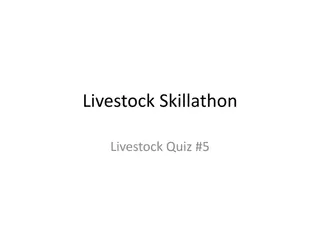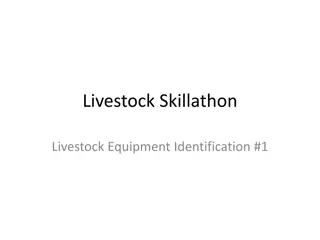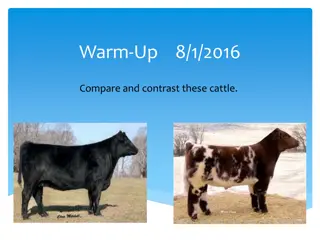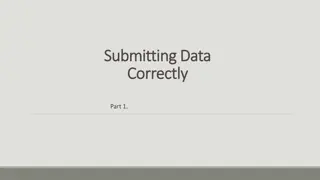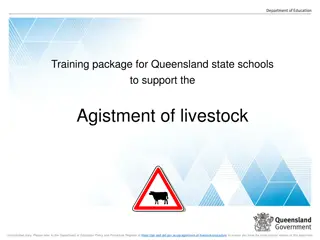Understanding and Implementing Survey Methodology in Livestock Studies
Explore the importance of survey methodology in livestock studies, focusing on the NAHMS Goat 2019 Coordinator workshop. Learn about survey design, sampling, external population study criteria, and reducing non-response rates. Discover key interviewer behaviors to minimize measurement errors and establish rapport with respondents for accurate data collection.
Download Presentation

Please find below an Image/Link to download the presentation.
The content on the website is provided AS IS for your information and personal use only. It may not be sold, licensed, or shared on other websites without obtaining consent from the author. Download presentation by click this link. If you encounter any issues during the download, it is possible that the publisher has removed the file from their server.
E N D
Presentation Transcript
The Survey Interview NAHMS Goat 2019 Coordinator workshop July 24, 2019
Survey Methodology Small changes in wording make big differences (so says Survey Methodology research) NAHMS studies are based on Survey Methodology discipline Survey = a systematic method for gathering information from a study population for the purposes of constructing quantitative descriptors of the attributes of a larger target population
External Population Study design selection criteria Generalization Extrapolation Target Population Selection Sampling design random selection Statistical weights Study Population
Introductory script Hello, my name is Mary Smith, and I work for the USDA s Veterinary Services. Let me show you my identification. The USDA is conducting a nationwide survey, and we are interested in talking to people about their goat operation on a variety of topics, including You should have received a letter from USDA s National Agricultural Statistics Service telling you about this survey.
Interviewer behavior to reduce measurement error 1. Rapport with Respondent 2. Read questions exactly as worded 3. Explain process and procedures 4. Probe nondirectively 5. Record answers accurately
1. Rapport with Respondent Interact with respondent in a way that is a. Professional b. Task oriented c. Minimizes potential of respondents to infer preferences for kinds of answers that are obtained Goal: Important for Interviewer to establish the right kind of relationship with respondents that would allow them to feel free to answer the questions accurately and completely. Personal or formal? Effect on interview.
1. Rapport with Respondent Go for balance of warm and professional. 1. Refrain from expressing any views or opinions on topics covered in the questionnaire Refrain from presenting any personal information that might provide a basis for inferring what your preferences or values might be relevant to content of interview. Some informal chatting on neutral topics is good; but for most part interviewers should focus on the task. 2. 3.
2. Read questions exactly as worded Read questions exactly as worded
3. Explain Q&A process to respondent Q. Overall, how would you rate the school your child attends excellent, very good, good, fair or poor? A. I d say not so good .
3. Explain Q&A process to respondent I m going to ask you to pick one of the answers I read excellent, very good, good, fair, poor. I know this may seem artificial, and it is possible that none of those answers exactly captures the way you feel. However, the way a survey works is that we ask people exactly the same questions and have them choose from exactly the same answers. Then we can meaningfully compare the answers that different people give. If we change the questions, or we have people choose their own words, then it gets harder to actually compare what different people say.
4. Probing A probe is an attempt to obtain an adequate or complete answer by the Respondent when they fail to provide one. Interviewer should probe in a way that does not effect which response category is chosen, i.e. be nondirective. For close ended questions repeat the question and all response categories. For open ended, numeric questions try to get right format or more exact number.
Probing examples Yes, I had a few goats with lumps. About every seven months.
5. Record answers exactly as given Try to write narrative response verbatim and not paraphrase or summarize
Model of response process for survey questions Question Comprehension Information Retrieval Judgment / Estimation Reporting of response
Problems in answering survey questions 1. Failure to encode the information sought E.g. witnesses of same crime; dietary survey vs diary
Problems in answering survey questions 1. Failure to encode the information sought E.g. witnesses of same crime; dietary survey vs diary 2. Misinterpretation of the questions E.g. terms such as weekday or children 3. Forgetting and other memory problems 4. Flawed judgment or estimation strategies Multiple strategies, e.g. records, count, rate, guess 5. Problems in formatting an answer Primacy effect; recency effect 6. More or less deliberate misreporting 7. Failure to follow instructions, e.g. navigational errors
Problems in answering survey questions 1. Failure to encode the information sought 2. Misinterpretation of the questions E.g. terms such as weekday or children
Problems in answering survey questions 1. Failure to encode the information sought 2. Misinterpretation of the questions 3. Forgetting and other memory problems
Problems in answering survey questions 1. Failure to encode the information sought 2. Misinterpretation of the questions 3. Forgetting and other memory problems 4. Flawed judgment or estimation strategies Multiple strategies, e.g. records, count, rate, guess
Problems in answering survey questions 1. Failure to encode the information sought 2. Misinterpretation of the questions 3. Forgetting and other memory problems 4. Flawed judgment or estimation strategies 5. Problems in formatting an answer Primacy effect; recency effect
Problems in answering survey questions 1. Failure to encode the information sought 2. Misinterpretation of the questions 3. Forgetting and other memory problems 4. Flawed judgment or estimation strategies 5. Problems in formatting an answer 6. More or less deliberate misreporting 7. Failure to follow instructions, e.g. navigational errors
